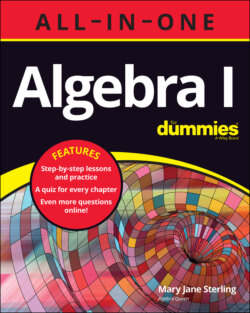Читать книгу Algebra I All-in-One For Dummies - Mary Jane Sterling, Mary Sterling Jane - Страница 75
Coordinating Fractions and Decimals
ОглавлениеIN THIS CHAPTER
Simplifying and changing fractions
Making proportions work for you
Operating on fractions and decimals
Linking fractions and decimals
At one time or another, most math students wish that the world were made up of whole numbers only. But those non-whole numbers called fractions really make the world a wonderful place. (Well, that may be stretching it a bit.) In any case, fractions are here to stay, and this chapter helps you delve into them in all their wondrous workings. Compare developing an appreciation for fractions with watching or playing a sport: If you want to enjoy and appreciate a game, you have to understand the rules. You know that this is true if you watch soccer games. That offside rule is hard to understand at first. But, finally, you figure it out, discover the basics of the game, and love the sport. This chapter gets down to basics with the rules involving fractions so you can “play the game.”
You may not think that decimals belong in a chapter on fractions, but there’s no better place for them. Decimals are just a shorthand notation for the most favorite fractions. Think about the words that are often used and abbreviated, such as Mister (Mr.), Doctor (Dr.), Tuesday (Tue.), October (Oct.), and so on! Decimals are just fractions with denominators of 10, 100, 1,000, and so on, and they’re abbreviated with periods, or decimal points.
Understanding fractions, where they come from, and why they look the way they do helps when you’re working with them. A fraction has two parts:
or
The denominator of a fraction, or bottom number, tells you the total number of items. The numerator, or top number, tells you how many of that total (the bottom number) are being considered.
In all the cases using fractions, the denominator tells you how many equal portions or pieces there are. Without the equal rule, you could get different pieces in various sizes. For example, in a recipe calling for cup of flour, if you didn’t know that the one part was one of two equal parts, then there could be two unequal parts — one big and one little. Should the big or the little part go into the cookies?
Along with terminology like numerator and denominator, fractions fall into one of three types — proper, improper, or mixed — which I cover in the following sections.
